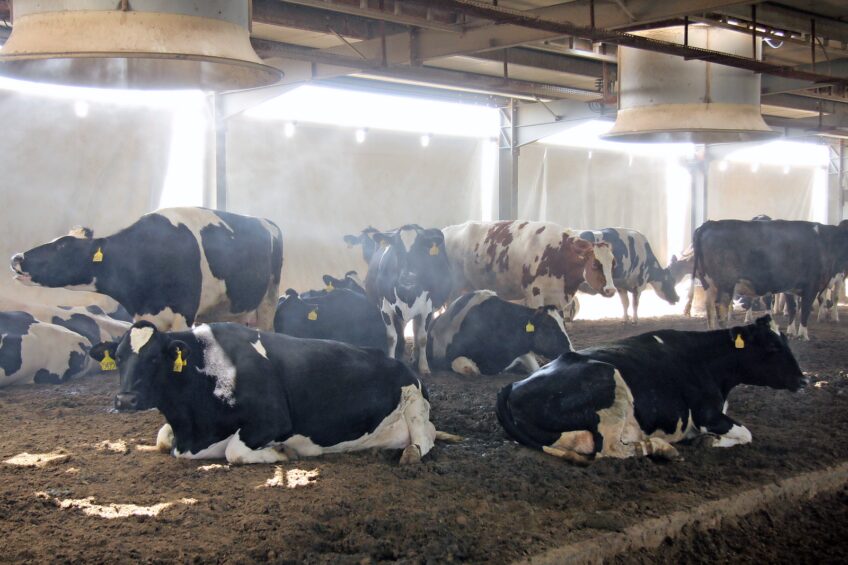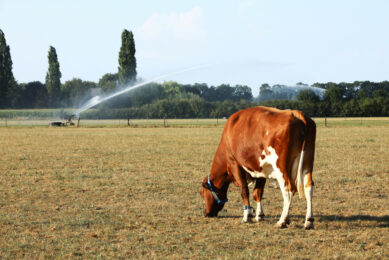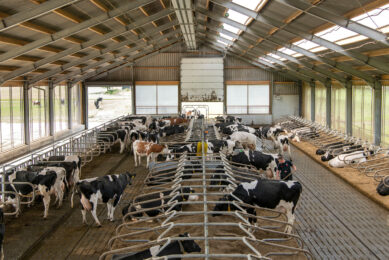Managing heat in the desert

Dairy cows need optimal conditions to be productive. Warm climates like in the Middle East, do not contribute to achieving the goal. Dr Rami Hamad of Al Rawabi in Dubai however, knows how to manage the herd and protect the cows from heat stress. Excellent production figures are the result.
Dairy cattle are often associated with nice green meadows where they can be seen grazing. Unfortunately not everywhere in the world is this romantic picture a reality. Like in the emirate Dubai in the Middle East. Here, hardly any crops are grown. In this harsh environment, temperatures can soar up to over 50 degrees during the summer. Cattle are fed only with imported hay and fodder and they are kept in herds in relatively small pens with indoor and outdoor access.
“Nonetheless, we have the best breeding results in the world”, says Dr. Rami Hamad. Together with his 220 staff, Rami is farm manager of Al Rawabi Dairy Co in Dubai, UAE. Al Rawabi is such a farm, keeping about 12,000 head dairy cattle, usually 6,500 – 7,000 of which are in production most of the time. The rest are dry (pregnant) cows, calves en heifers.
Understanding the language
“It is a misunderstanding that cows under these conditions would be unable to be highly productive”, says Rami. “But you need to understand their language and their behaviour and respond accordingly in managing the herd. We don’t copy anybody and we don’t consider their instruction book as a holy book. On the contrary, we use the cow as our guidance. We have proven to be successful in our approach as we achieve very satisfying production figures. One parameter for example is a mastitis degree of only 0.3%. To a large extent that is thanks to our management of keeping the facilities clean. We do our best and avoid using any medicine. If its not necessary, stay away from medication!
Another parameter is the “rolling herd average” (RHA) production of 31 litres of milk per cow per day, says Rami. Unlike in Europe, we are not interested in very high protein and fat content of milk. In our country high production volumes are more important, with keeping standard fat and protein levels.
Farm manager DR Rami Hamad of Al Rawabi: “You need to permanently monitor and understand the behaviour of the cows. And adjust the cooling mangement accordingly”.
We also don’t have fly problems, as we continuously cultivate the sand bedding. That will dry the sand off and kills the eggs. Hygiene of the yard and health of the animals are key. We are convinced about that and therefore we take these measures. Cultivation of the yard also kills anaerobic bacteria. On top of that, the cows enjoy laying in the cultivated sand. We cultivate every two to three days, but daily during the rainy period. It is a comprehensive set of measures to achieving these good results. But you need to tweak, adjust and respond to the current conditions all the time.”
Permanent monitoring
“By far the most important measure is constantly monitoring the heat conditions”, Rami continues. “And to watch how the cows are responding to the situation. We keep all our
productive cattle on one location. They are kept in groups which need dedicated heat management. These are high productive, medium productive, low productive and dry (pregnant) and calving cows. These different types of cows are fed different rations with different levels of energy. The more energy is in the feed, the more cooling they need.
Not just the type of cow is important. Also every house is different and not to forget the wind direction”, says Rami. “All of these factors are determining the heat management of the herd. That makes you to think “out of the box” and learn to read the cow.”
“All our houses are equipped with Korral Kool coolers from the US”, says Rami. “These dispense a sort of mist to cool down the cows. The coolers are positioned in the laying areas of all the houses. The cows like to be underneath them when it’s hot outside. We constantly monitor the herd. If many of them are outside, it may be to “cold” inside. Depending on the situation, we may need to change the intensity of the cooling. For that purpose, there are five stages of water supply available. And like I said, we must monitor the behaviour of the cows. It is like the famous Mona Lisa painting by Leonardo da Vinci. What do you see when you look at the painting? The same applies to the cooling management of the herd. Observe the cows and they will let you know what they need.”
Inseminating in summer
Since Rami Hamad has a clear vision on cooling management, he has proven that inseminating heifers during the summer season (June – September) is absolutely no problem, as long as they are being cooled down. Inseminating heifers is uncommon during the summer in the Middle East. But Rami has proven that this is possible, as long as the right measures are taken. “We have a conception rate of 64%”, he says. “That is very high, given the fact that the average first conception rate of the herd is 35%. Moreover, it is absolutely necessary to cool down the dry ones. That will lead to a better calf and better milk production once they start lactating.”
Showering walkways
Apart from cooling down the cows through the Kooral coolers, Rami Hamad also has a clear vision on feeding them in relation to milking. For that purpose, Al Rawabi has three Boumatic fishbone milking parlours, with 210 milking stalls in total (two parlours of 30/30 each and one of 45/45). The cows are milked three times a day. “Once they leave the parlour, you must stimulate them to eat before they are in their compartment again”, says Rami. In order to achieve that goal, the cows pass through a shower walkway. “There, the water cools down their body temperature, stimulating them to eat”, according to Rami. “Imagine that you yourself are feeling cold. You need a decent meal to feel track again”, he says. “The very same holds true for the cows. If they feel cold, they will start eating and that provides energy for them again. They need that to be productive. And that’s what they are for!”
Join 13,000+ subscribers
Subscribe to our newsletter to stay updated about all the need-to-know content in the dairy sector, two times a week.














